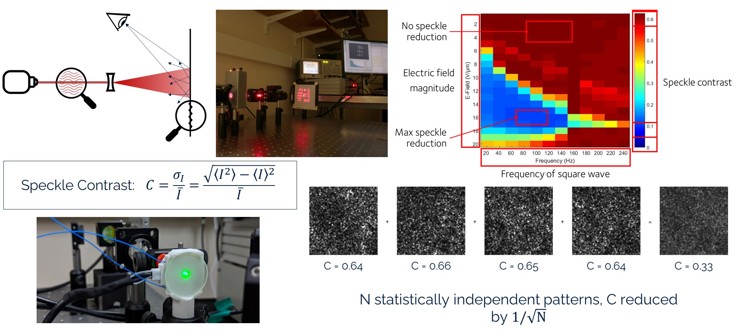Soft Matter Photonics: Research - Laser Speckle & Liquid Crystal Speckle | Engineering Science Department - University of Oxford

Characterising Laser Speckle and Liquid Crystal Speckle Reducers
The properties of laser light, such as the high spectral purity and collimation, make them ideal for display projection, microscopy and medical imaging applications. When multiple laser sources of different wavelengths are combined it allows for a much larger range of colours to be produced than with other light sources such as LEDs. Unfortunately, the coherence of a laser results in speckle which degrades the quality of an image. Existing technologies, such as rotating diffusers, can mitigate this problem but at the cost of increased size, power consumption and mechanical vibrations, which makes them unsuitable for many applications.
We have developed a compact liquid crystal (LC) technology that can reduce laser speckle by as much as 90%, making it virtually impossible to see with the naked eye. The basic operating principle of the device is that it consists of an electro-active thin film of LC that generates a continuous series of independent speckle patterns with the application of an external voltage. These statistically independent patterns are generated because the thin-film imparts a spatially random phase modulation to light that is transmitted through the device. When observed within a finite integration time, this results in a reduction in the observed speckle pattern (Figure 1).

Figure 1. Photographs of images generated using a prototype projector system (modeled on a HITACHI CP‐X250 Multimedia LCD Projector): a,d,g) without our LC technology; b,e,h) with our LC diffuser operated under suboptimal electric field conditions; and c,f,i) with our LC diffuser operated under optimal electric field conditions. Image from (https://onlinelibrary.wiley.com/doi/10.1002/adpr.202000184)
Our speckle reducers allow for analogue control of the speckle contrast that is hysteresis-free and stable over time. We have shown that the speckle reduction is consistent for at least 30 hours. The device can be operated at temperatures reaching 120 degrees and shows no damage when exposed to optical powers of at least 2W. Our device has no moving parts and so is vibration free and does not have the same lifetime issues as the alternative technologies. We have developed a range of integrated prototype devices for testing on optical benches and for integrating into existing optical systems.

Figure 2. Characterising Laser Speckle.
The team has also established a semi-automated characterisation system for quantifying the amount of speckle contrast present in an image (Figure 2), which has been set-up to emulate the response of the human eye in terms of how it perceives speckle. Moreover, the operating parameters of this characterisation system are in accordance with the recommended practice for the measurement of speckle in laboratory conditions as defined by the Laser Illuminated Projector Association. Our system (Figure 2) allows for a real-time measurement of the Speckle Contrast, C, and enables a full sweep of the electric field parameters of the optoelectronic device under test.
Researchers
Yihan Jin, Nathan Spiller, Dr David Hansford
Publications
Laser Speckle Reduction using a Liquid Crystal Diffuser Enhanced with Redox Dopants
Yihan Jin, David J. Hansford, Steve J. Elston, Stephen M. Morris Adv. Photon. Res. 2, 2000184 (2021)
David J. Hansford, Yihan Jin, Steve J. Elston & Stephen M. Morris Scientific Reports 11, 4818 (2021)
Speckle contrast reduction of laser light using a chiral nematic liquid crystal diffuser
David J. Hansford, Julian A. J. Fells, Steve J. Elston, and Stephen M. Morris Applied Physics Letters 109, 261104 (2016)
